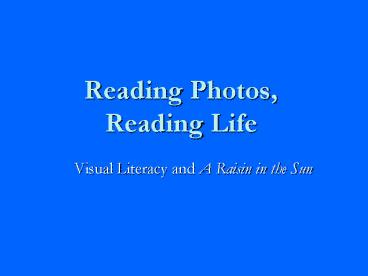Reading Photos, Reading Life - PowerPoint PPT Presentation
Reading Photos, Reading Life
Visual Literacy and A Raisin in the Sun. What is Visual Literacy? ... these images to A Raisin in the Sun? Now that you have read A Raisin in the Sun how do you ... – PowerPoint PPT presentation
Title: Reading Photos, Reading Life
1
Reading Photos, Reading Life
- Visual Literacy and A Raisin in the Sun
2
What is Visual Literacy?
- Visual Literacy is ability to read non-print
visual texts. For example, photographs,
paintings, sculptures and movies. - When we look at pictures we infer ideas about
what is happening and what is not happening in
the non-print visual text. - These ideas come from the history we know and our
own personal thoughts and ideas. - http//condor.depaul.edu/aam/6-4-02MonroFinalProj
ect/Presentation/RPRLClass1.ppt
3
What is the aim of Visual Literacy?
- The purpose of being able to read a non-print
text is to help you make connections between the
things you already know to the things you are
going to be learning. - Being able to make these connections helps you to
truly learn and know things. - http//condor.depaul.edu/aam/6-4-02MonroFinalProj
ect/Presentation/RPRLClass1.ppt
4
Time to LearnTime to Practice
5
Reading a Photo
- To Read a Photo, you must do the following
- Observe the photo for 2 minutes for overall
impression and then individual items. - Make a list of what you see and dont see
People, Objects Activities - Make a list of inferences from what you see
- Make a list of questions the photo raises in you
mind - Where could you go to find the answers to your
questions?
http//www.archives.gov/digital_classroom/lessons/
analysis_worksheets/photo.html
6
What do you see here?
http//memory.loc.gov/cgi-bin/query/I?fsaall1./t
emp/ammem_sOoJdisplayType1m856sdfsam856sf8
a29884_at__at__at_fsaal
7
What do you see here?
http//www.loc.gov/exhibits/treasures/images/vc84.
jpg
8
What do you see here?
http//www.whitney.org/jacoblawrence/art/migration
.html
9
What do you see here?
http//www.loc.gov/exhibits/african/images/adams.j
pg
10
What do you see here?
http//www.historychannel.com/broadband/clipview/i
ndex.jsp?idtdih_0828
11
What did you learn?Extension Activity
- How can you connect these images to A Raisin in
the Sun? - Now that you have read A Raisin in the Sun how
do you view these images differently than in our
preview activity? - How are viewing primary sources different than
reading literature? - How does using primary sources enhance your
understanding?
PowerShow.com is a leading presentation sharing website. It has millions of presentations already uploaded and available with 1,000s more being uploaded by its users every day. Whatever your area of interest, here you’ll be able to find and view presentations you’ll love and possibly download. And, best of all, it is completely free and easy to use.
You might even have a presentation you’d like to share with others. If so, just upload it to PowerShow.com. We’ll convert it to an HTML5 slideshow that includes all the media types you’ve already added: audio, video, music, pictures, animations and transition effects. Then you can share it with your target audience as well as PowerShow.com’s millions of monthly visitors. And, again, it’s all free.
About the Developers
PowerShow.com is brought to you by CrystalGraphics, the award-winning developer and market-leading publisher of rich-media enhancement products for presentations. Our product offerings include millions of PowerPoint templates, diagrams, animated 3D characters and more.





















![Download Book [PDF] Marisa Berenson: A Life in Pictures PowerPoint PPT Presentation](https://s3.amazonaws.com/images.powershow.com/10071839.th0.jpg?_=20240704126)
![[PDF] DOWNLOAD Alan J. Pakula: His Films and His Life PowerPoint PPT Presentation](https://s3.amazonaws.com/images.powershow.com/10067608.th0.jpg?_=20240628039)







![[PDF] Health Promotion Throughout the Life Span 9th Edition Full PowerPoint PPT Presentation](https://s3.amazonaws.com/images.powershow.com/10079280.th0.jpg?_=202407160512)
